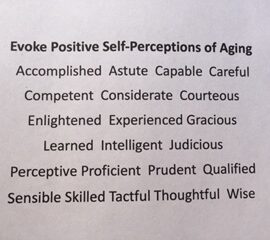Your view of aging matters
You can develop a positive view of getting older
Part of developing a positive mental attitude involves adopting a positive attitude toward growing older. American cultural norms do not, however, often support such a positive attitude. To the contrary, most people perceive aging in a negative light. One of my previous blog posts (Your View of Aging) showed that negative perceptions toward aging affect our longevity and health. But is it possible to change a negative view of aging into a positive view of aging?
We acquire age stereotypes over time by unconsciously incorporating statements about aging and watching older people in their daily lives. Age stereotypes can then influence self-perceptions of aging. If age stereotypes can be changed with interventions, then older people whose age stereotypes change might be more likely to engage in healthy behaviors. However, age stereotypes may be difficult to change using explicit methods because entrenched attitudes underlying age stereotypes might overwhelm messages designed to change them.
Thus, researchers developed a subtle approach (Levy et al. 2014) to determine if implicit (subliminal) messages might be more effective than explicit messages to change age stereotypes. The 100 research subjects 60 years or older were recruited from the New Haven, Connecticut area. The implicit intervention included three sets of 20, primarily positive words relevant to old age, flashed on a computer screen at a rate fast enough to escape conscious detection. The words were flashed on four different days over an eight-week period.
Participants in the explicit message group were told to imagine then write about a physically and mentally healthy senior citizen (on one day during two different weeks), write about a physically and mentally healthy female senior citizen (once during another week), and a physically and mentally healthy male senior citizen (once during another week), all during an eight-week period. Subjects in the control group (a neutral implicit intervention) were told to imagine neutral topics then write about them.
Compared to subjects who received the neutral implicit intervention, subjects in the implicit positive message group showed significant increases in positive age stereotypes, positive self-perceptions of aging, and physical function at weeks 5, 6, and 8 of the study. Subjects in the explicit intervention did not show significant increases in positive age stereotypes, positive self-perceptions of aging, or physical function compared to the control group.
The implicit positive age stereotype intervention during weeks 2-5 increased positive age stereotypes at week 5, which increased positive self-perceptions of aging at week 6, which increased physical function at week 8. Talk about quick results! The repetitive nature of the intervention may have been responsible for its success. The positive implicit intervention also reduced the negativity of age stereotypes and self-perceptions of aging.
Here’s an exercise from my book, Choose Better, Live Better – Nine Healthy Choices that Nurture Body, Mind, and Spirit, that uses explicit messages to improve your self-perceptions of aging over the next three weeks.
Write one of the words below on a sticky note and post it in a place where you’ll see it frequently—such as on your refrigerator or your bathroom mirror. The order that you use the words doesn’t matter.
Accomplished Astute Capable Careful Competent Considerate Courteous Enlightened Experienced Gracious Learned Intelligent Judicious Perceptive Proficient Prudent Qualified Sensible Skilled Tactful Thoughtful Wise
When you see the word, reflect for a moment on your feelings about it. Think of an older person whom you know who exemplifies the word. Leave the word in place for a week, then replace the sticky note with one with a different word from the list.
Over 23 weeks, you’ll be primed daily with positive self-perceptions of aging.








